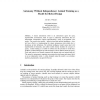Free Online Productivity Tools
i2Speak
i2Symbol
i2OCR
iTex2Img
iWeb2Print
iWeb2Shot
i2Type
iPdf2Split
iPdf2Merge
i2Bopomofo
i2Arabic
i2Style
i2Image
i2PDF
iLatex2Rtf
Sci2ools
WRAC
2005
Springer
2005
Springer
Autonomy Without Independence: Animal Training as a Model for Robot Design
A classic autonomous robot is an autonomous agent for open, unpredictable environments. Such an agent is inherently autonomous but not independent. Independence implies unpredictability, which is incompatible with agency. The current robot models – behavior based and artificial intelligence – have not been effective at implementing the classic autonomous robot model due to limitations in their definitions. The artificial intelligence model cannot deal with unpredictable environments, and neither model directly includes the concept of agency. Animal training as a model for robotics has the potential to avoid these problems. Animal training has several advantages. It has an inherent model of agency. Goals and behavior are formally separated into human goals and animal behavior. The animal is autonomous, requiring conversation between human and animal, but it is not an independent entity. A robot designed using this model is an articulate machine, programmed as an agent for the user.
Artificial Intelligence | Classic Autonomous Robot | Model | Unpredictable Environments | WRAC 2005 |
| Added | 28 Jun 2010 |
| Updated | 28 Jun 2010 |
| Type | Conference |
| Year | 2005 |
| Where | WRAC |
| Authors | David C. Wyland |
Comments (0)

